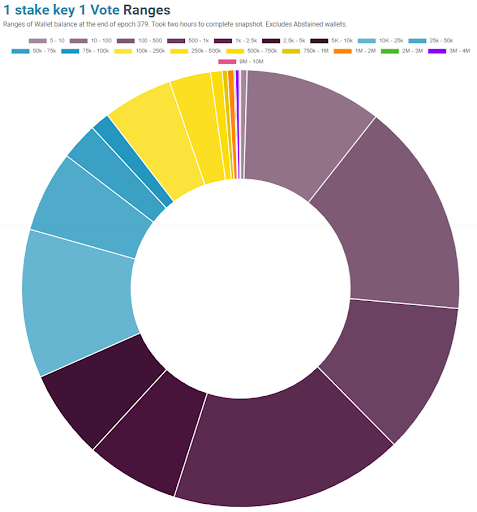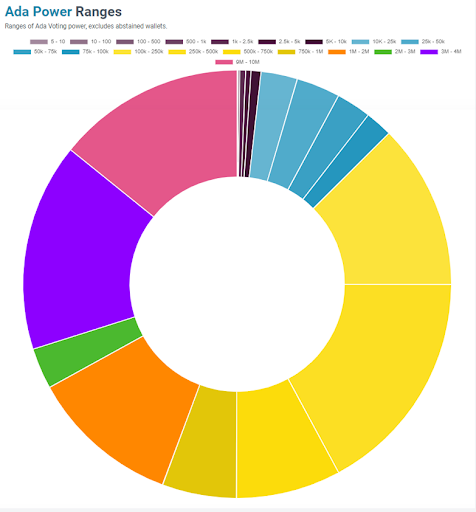“Decentralized Governance” and “Power to the edges” are two ways of framing one oft-cited promise of a blockchain future. In today’s world, centralized power and de-facto oligarchies are global realities which lead to problems, great and small. Some who imagine different possibilities see blockchain as a tool that could facilitate that future. Today we will consider a recent event in the Cardano Community, the election of the fourth Catalyst Circle. This election marked a small step for mankind and also highlighted that the moon is still pretty far away.
Catalyst Circle is described as a “human sensor array” for the Project Catalyst experiment. The Circle is tasked to meet regularly to discuss the goings-on in Project Catalyst. Specifically, their founding goals are:
- To facilitate communication between the different functional groups
- To provide a heads-up when red lines are crossed within a certain group
- To suggest improvements on plans and processes that shape Project Catalyst (including the Circle itself!)
Voting for the fourth iteration of Catalyst Circle (CCv4) occurred in December 2022. This small group was first founded in July 2021; members of the Circle are voted in by the community and serve a term of several months (term length has varied). CCv4 marked a pivot point for the Circle, both in its structure and how the voting took place. Previous Circles were comprised of representatives from stakeholder groups in the Catalyst ecosystem - Proposers, Proposal Assessors, Toolmakers, Stake Pool Operators, General Ada Holders, Cardano Foundation, and IOG. The naming of Cardano Foundation and IOG representatives occurred within those organizations. For the public roles, a “public vote” took place in a fairly outlandish manner: Attendees at a certain Zoom call voted for their preferred representatives via Google Forms, during the Zoom call, after candidates presented themselves. If you’ve ever wondered what it would be like to be in the room with the founders of a new nation, jostling and farting and shouting “aye!” and “nay!” and shoving their chosen leader up to the podium, you may have thought those days were long gone. Not so, it seems, save that Zoom shields us from the farting.
Reflecting on the third bullet point above, it seems that previous iterations of the Circle have done their job as far as suggesting improvements to their own continuing formation. For CCv4, two changes are notable:
1)Rather than comprising seven “representatives” of stakeholder groups, the Circle is just five members who run for office on a platform outlining their leadership intent.
2)Voting takes place on-chain, using the voting power of ada in linked wallets.
Many corners of the community pitched in to facilitate these changes:
- Candidates for the Circle were recruited through Town Hall meetings and grass-roots interpersonal communication.
- Platform Statements from candidates were rounded up and published on the Cardano Forum.
- DripDropz developed an on-chain voting platform, published a blog and how-to video to aid voters, and appeared at a Town Hall meeting to explain the process
- Lido Nation developed a reporting dashboard to show various vote analyses while voting was live - and as a final capture of results.
- @HoskyToken and @QuasarSure contributed 100 Billion $HOSKY and $DISCO tokens respectively as voter incentives, to be distributed to voters who register for reward distribution on Lido Nation.
- The community at large shared thoughts and ideas on social media, and the DripDropz team was very responsive to live feedback!
As a sideline observer, it was fun to see this decentralized cooperation coming together live at the Rare Bloom event in October 2022. The deadline for candidate nomination was imminent; between meetings and events, @stoicpool was running around with a video camera with a large furry microphone, recording candidate platform statements. Energy was up, and several good candidates were pulled into the race at the last minute.
On-chain voting took place at dripdropz.io in early December. I checked in on the live results several times during the voting period, and it was a lively race! Popular candidates were evident early in the race, but the final results were unclear until the very end. In the end, five reputable candidates were elected, and we look forward to seeing what follows from their leadership! For the sake of this article, we will keep our attention on the governance process itself.
First, let’s consider overall participation. While voting power in this election was based on ada, not individual voters, we can get as close as possible to a measure of participation by looking at unique stake addresses participating. A total of 1140 unique stake addresses participated in the election. This compares favorably to the previous “Zoom” elections, where each electable seat only engaged a few dozen voters at most!

This chart represents the 1140 Voters by wallet size. Two-thirds of voters - the whole purple spectrum - hold less than 10K ada in their wallets.
Next, let’s consider the effect of ada holdings on the vote. Remember, the design of this election was not “1 stake key” = “One vote” – this wouldn’t make sense anyway since a stake key isn’t actually the same as a unique identity. When viewed through this lens, the difference is staggering. Here we see that voters with less than 10K ada in their wallets, though they comprised 70% of the voting wallets, contained less than 2% of the voting power.

NOTE that the color scheme between these two charts is THE SAME - the purple spectrum that dominates the first chart is nearly invisible in this chart because their monetary voting power amounts to so little
The ultimate effect is that 40% of the voting “power” lay in the hands of 10 wallets with more than 1M ada. If we search down to 500K ada, we can account for 60% of the voting power and only bring in 13 more voting wallets. With the spread across the top 7 vote-getters amounting to only 10M ada, it is perfectly possible that the single 10M ada voting wallet could have decided the whole election. So the question is: did we ultimately do any better than the zoom elections, where only a few dozen could participate?
While these results are jarring, our purpose in reporting is not shock-effect. Rather, we are here to look clearly at the facts we can find so that we can build forward together. At the top of my list of next considerations is thinking about how this applies to Project Catalyst. Compared to the total 66.8M ada that participated in the CCv4 election, more than 3.6B ada registered to vote in the most recent round of Catalyst (Fund 9; voter registration stats according to info shared verbally from IOG). Do one or two whales still hold such disproportionate power when swimming in that much bigger pool? The answer is - yes, probably. Many proposals, including winning ones, count only 200-odd votes cast per proposal - not very different at all than the numbers of participants in the Circle vote and, therefore, in the influence that a small number of voting wallets must yield. The exact comparables (exact voting power of specific voting wallets, etc. - things we WERE able to see in the CCv4 election) are not publicly available. Catalyst votes are recorded on a private blockchain behind closed doors at IOG. That makes this peek at the raw data of a blockchain vote all the more valuable!
The question of where to go next is not being ignored. The first change we are likely to see will be with the launch of “dReps,” still slated for Fund 10 in early 2023. The idea with dReps is that instead of every voter trying to make sense of 1000+ proposals and taking the lengthy time it would take to vote up or down on every one, that instead, voters could delegate their voting power to one or more “dReps.” The dReps would be responsible for voting with all the voting power delegated to them. This would allow the aggregation of power of many small wallets, which would then be used to exercise more overall voting “power” than if all those individuals just did however much voting they wanted to. While I can’t help but groan a bit when I think about the politicking this system will inevitably engender, I’m still excited to witness another variable in the experiment and see what we will learn from it.
Leading up to the Cardano Summit 2022, the Metadata Tools team at the Cardano Foundation was tasked to develop an app to support voting for the “Speaker election” that fueled the second day of speaker presentations at the Summit. The tool they developed was useful for the fun, relatively low-stakes election it enabled. It succeeded in limiting voting power to 1-wallet=1-vote; ada holding was not a factor. However, anyone who cared to go to the trouble could vote with multiple wallets, while those with only Ledger wallets could not participate at all. Nevertheless, various problems were contemplated and solved in this project. The results are open-sourced, providing a stepping stone for the next builders to use and improve.
The goal, many suggest, is a Decentralized Identity solution (DID) that truly allows for 1-person=1-vote. Atala Prism, RootsID, and IAMX are all projects that are working on Decentralized Identity. If you’ve heard about DIDs but weren’t sure what they’d be used for, the answer is “lots of things,” but let today’s elucidations be your first shining example.
You can learn more about the results of the CCv4 election in Lido Nation’s Catalyst Explorer tool, which includes the charts cited here as well as other interesting breakdowns. Leave your observations in the comments!



No comments yet…